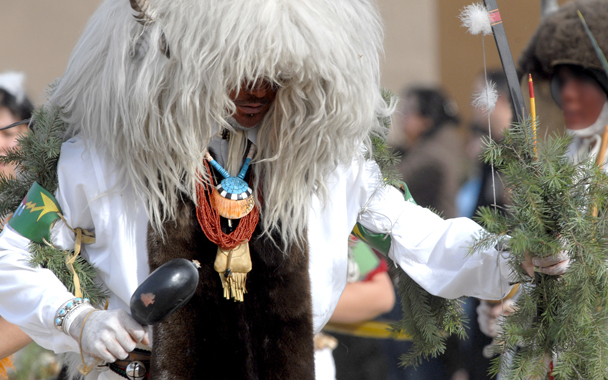Cecelia McCord, a New Mexican farmer, spends the holidays with hordes of people, all of them relatives. “Forty, not counting guests,” she says. “The holidays are really about sitting around the kitchen table and everyone doing something. You cook, do dishes, cook the next meal, do dishes again. It’s kind of crazy, but it’s amazing fun.”
Despite the closeness of Cecelia’s large family and its roots in New Mexico that go back to the 1600s, their holiday traditions are changing. One change entails a whole new feast, and this is because one of Cecelia’s five sisters is married to the governor of Pojoaque pueblo. Like all the pueblos, Pojoaque has a winter feast day, and this one comes right between Thanksgiving and Christmas. Dances take place over the day in the pueblo’s plaza, and afterward people are invited to the governor’s house to share a meal. As a great many people will need to be fed, Cecelia’s mother and sisters jump into a major cooking marathon right after Thanksgiving.
The morning of the feast day was sunny and cold, with blinding azure skies and just enough wind to keep the air from ever warming—December weather in New Mexico. A friend and I stood in the cold plaza for a very long time before the deep heartbeat sound of drums issued forth from behind a far building. Drummers and singers slowly emerged and took their places in the plaza, followed by a long line of dancers that began with the eldest members of the pueblo and ended with toddlers. It was a buffalo dance, and so the men wore enormous buffalo headdresses with eagle feathers cascading down their long, furry “buffalo” backs. As we stood there, watching the mesmerizing movements of the dancers, we gradually forgot how cold we were.
Pueblo dances unfold at their own unhurried pace, as did the feasting at Cecelia’s brother-in-law’s house. We took a seat in the governor’s living room and chatted quietly with the other guests, who included farmers and the leader of the Cherokee nation in Oklahoma. Eventually, we were motioned into the kitchen, where two large tables were set with white linens. Two places awaited us at one table, and we joined the others there who were already eating. Cecelia’s mother appeared and set down small bowls of green chile–buffalo stew, a warming dish that worked to take away the chill. Cecelia had grown the chile; the buffalo was from a nearby pueblo. This was followed by other traditional dishes—pinto beans cooked with chicos (dried corn), garbanzo beans with ham, two kinds of enchiladas, red chile, posole with chicken, and sweet bread pudding with raisins and cheese. The hand-painted dishes we were given to eat from held only a few bites, so we had a taste of one dish, then a taste of another. As we ate, fresh bowls of hot food were brought to the table and the cold food was taken away. People chatted, again quietly, passed bowls and ate. With a roomful of guests waiting, we didn’t want to stay too long, yet no one was rushing anyone to finish and leave. Finally, we rose, said goodbye to everyone at our table, then thanked Cecelia’s mother and sisters, who warmly invited us to return later.
On the way out, we passed a sideboard covered with cakes, pecan sandies, traditional fruit turnovers, and Cecelia’s star-shaped bischochitos. They were so flaky and crisp that each bite shattered into the shards of anise-scented pastry. When we stepped outside into the bright sun, neither of us could imagine such things as traffic, Christmas shopping, and deadlines. The dry grass and snow-fringed mountains in the distance seemed utterly sufficient. We both felt at peace.
This wasn’t a restaurant meal, but it wasn’t exactly a dinner party, either. I can’t think of anything my culture does that’s remotely like this, but I wish there were such a tradition. The experience felt deeply civilized, and it was a privilege to sit in that warm, clean kitchen at a table among strangers, the women gracefully serving food, quietly washing dishes, then resetting fresh places while their guests ate and visited. The food was clean and pure, the small tastes deeply nourishing. The meal felt like a true sacrament.




 Pinterest
Pinterest


